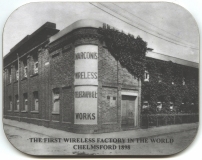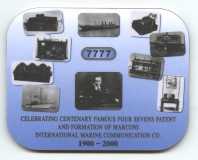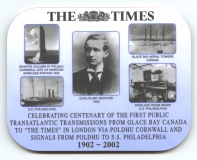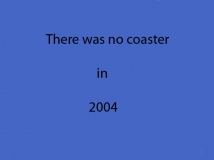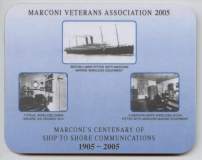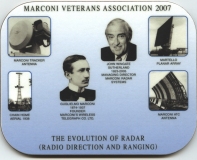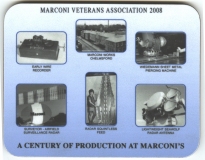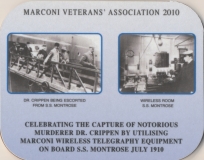The annual International Marconi Day was held at the Chelmsford Science & Industrial Museum, Sandford Mill. Chelmsford Amateur Radio Society (CARS) http://www.g0mwt.org.uk/ play a major part in this event.
Coasters 1998 – 2010
MVA President 2010
Our president for the year 2010 is Veteran Ron Bradbrook, ex Broadcast Transmitter Development, Marconi Comms.

At the reunion, Ron was introduced by Past President and Veteran, Raymond Rowe.
A transcript of Raymond’s speech and Ron’s response in included below
Raymond Rowe
There’s a lot of old people here isn’t there?
Mr Chairman, Mr President, fellow Veterans. Now some of you know Ron Bradbrook more will have heard of him or about him there are even more who do not know about him at all or why he deserves to be our president. So, for those of you unaware of his background, or not having had the pleasure of knowing him, I will give a brief resumé of his early years and his contribution to the Marconi Company.
Ron was born in Barking and moved early on to Writtle. After the benefits of the local school he passed the exams to attend Chelmsford Technical College.  At the Tech. his contemporaries were our past president Charles Rand and a Mr Luxom   They all joined Marconi’s as craft apprentices.  During his apprenticeship he did his National Certificate studies at the Tech.; he had spells at Pottery Lane, Hut 3 at Baddow, Writtle and the dreaded Building 46 in New Street. In Building 46, as an apprentice, he came under the influence of engineers such as Tommy Thompson and Frank Page. These set him off in a sound direction. National Service saw him on a beach near the Nile during the time when we thought we still had an Empire.
After National Service he rejoined Marconi as a development engineer and found himself in Building 46 working for a very fine senior engineer, Douggie Bowers. This is where high powered transmitters started to take over his working life.  He had a number of trips overseas solving problems in places such as Rwanda where he got some very large MF transmitters to work in rather difficult circumstances. His abilities and sound engineering were ideal in an area where you are dealing with high power equipment that can be lethal. This is engineering with a capital “Eâ€. I could list some transmitter type numbers but few of you would know them, however, some are known and remembered across the world, they range in power levels from 1kW to 750kW in all the broadcast wavebands.  I must point out that this is real power, not some of your current digital pulse power, this is power where, in a couple of minutes, all of you could cook all of your Christmas dinners in one go. Now, as I have said, these transmitters include lethal voltages and very high RF power levels. A lot of this equipment was designed and operated before Health and Safety was born. Quality engineering and attention to detail has established equipment that has stood the test of time in performance, reliability and safety. These transmitters were and are being used around the world. BBC World Service relies on 250kW and 300kW HF transmitters, Voice of America is reaching parts of the world that satellites cannot cover with the more recent 500kW HF transmitter. Droitwich Long Wave is still covering most of Europe for the BBC.
Going back, was it 30 Years ago, there was a major change in MF frequency allocations in the medium wave band and the BBC had to renew their MF stations. They chose a combination of our 50kW Doherty (B6034) transmitters to produce power levels of 100, 150 and 200kW. These replaced Marconi  transmitters that were installed some 50 years earlier.   As Tom Mayer’s remarked at the time to a senior BBC man “It is difficult to build a business when you only get an order every 50 yearsâ€.
This was a major project for Marconi’s and all had to be done in time to be installed across the country with a very public deadline. Then to keep the team on its toes came the replacement  of the BBC FM service. The BBC wanted to replace their FM services for Radios 1, 2, 3 and 4. This required the development of a range of equipment in 10 and 20kW using new valves and again it all had to be done to get them all installed in time for a deadline. I hope the installation and changeover from the existing FM transmitters to DAB will be as trouble free. But I have my doubts.
So we have all listened to BBC programmes transmitted from equipment designed by Ron and his team. I should point out that they were only responsible for the equipment, not the programme content, that’s down to the BBC.
Now I don’t want you to think that Ron did it all on his own. All large projects call for many people and many skills; design office, manufacture, contracts, handbook writers, installations, installation engineers and many others.  However, this range of activities needs authoritative voice that can cut through the problems and make a decision.  Your President was that man in Building 46.  Now how did he provide this direction of management and encouragement. Many times I have seen people walking up the New Street yard to Building 46, people, as I have said, from the IDO, contracts, manufacture, they all had a worried look about them. Were they going to a progress meeting perhaps?  Or to check on a drawing? Perhaps to admit to a problem? Or asking for clarification on something? They knew there would be a warm welcome on Ron’s office.  What do you want? What have you got wrong now? You’re not going to waste my time are you?  There’s a colleague of ours, Len Howard, who at Ron’s retirement presentation said  “Marconi’s gain when Ron joined was a great loss to the diplomatic serviceâ€.
No. Ron encouraged those who tried and put their best efforts into the job and brought the best out of his close associates but did not have much time for those that did not pull their weight for Marconi’s. Now he is not perfect in fact. When I moved into Building 46 as a microwave man I realised that we were at opposite ends of the spectrum. I realised that Ron had problems. He only seemed to drink Australian white wine and gin and tonic. I like to think I made an impression on him. He quickly learnt the pleasures of quality red wine and Scotch. So you see, even he can learn given time. What have I left out? He is an excellent darts player a very good friend and one who you can rely on always to give of his best. So you could not have a President stronger in Marconi credentials. Marconi leaves its mark on all of us and in Ron’s case I am sure it has modified his DNA in some way, it is a pity that it can’t be transfused in some way into the current bankers and politicians.
Fellow Veterans let me introduce your President Ronald Bradbrook.
Ron Bradbrook
Well, after an introduction like that it doesn’t leave much for me to say. The chap he was talking about sounded very interesting and I wish I knew him. I joined Marconi in September 1947 and the final year of that apprenticeship I was ordered to go to building 46. I really didn’t know what building 46 was all about. I knew of it, I knew it had something to do with transmitters but I had not been called upon to work at the New Street site until the final year of my apprenticeship.. But when I arrived there I soon discovered that it contained up to a 100 very very qualified very clever engineers and a drawing office to match and I wasn’t to realise how much it would influence my next 45 years with the company at that time. I remember two people quite vividly; one was Vic Tyler whose claim to fame was that he was a Mosquito pathfinder navigator during the War and that he was responsible for producing something called the Tyler high efficiency circuit that increased the conversion efficiency of RF amplifiers by about 10% and that stood the company in great stead against the competition for the next 40 years. And the other person I remember was Frank Page who suffered from Gout and he could be seen shuffling around Building 46 in carpet slippers and he was responsible for designing what came to be known as the Page cabinet, which was used for decades afterwards.
As Raymond said I did my National Service and on returning I went to work for the late Douggie Bowers on high power transmitters. And we didn’t have long to wait because the Diplomatic Wireless Service, then part of the Foreign & Commonwealth Office, came to us and asked us to produce a 1500kW MF transmitter. It was code named Beryl and it was achieved by designing two 750kW transmitters that were connected in parallel to give the required 1500kW. Sadly just after the war the component technology hadn’t improved as much as warfare and weapons and we had to use 16 of the largest valves that English Electric then produced to create the modulator and RF output stages. Because of that the transmitter was enormous. Those of you who don’t know Building 46 the one transmitter 750kW unit took up an areas of 50 metres by 12 metres and that’s some transmitter, a lot bigger than a communication one.
In 1960 the Voice of America and the BBC approached the company with a view to producing an higher power HF transmitter.  HF transmitters I should explain are those used for world-wide broadcasting and they were after a 250kW transmitter that was two and a half times bigger than anything previously produced and in the interim (this volcanic dust gets everywhere) the English Electric Company had produced this steam cooled valve known as the BY1144, which had the ability of producing 125kW of carrier and two of these were used in the output of both the modulator and the RF stages. Tom Mayer said that it was one of the most successful transmitters produced up to that point and they were made in large quantities and they were installed at BBC stations at Daventry, Rampisham, Skelton, a purpose built station on Ascension Island and at the VOA station at Wooferton which was the VOA programme operated by the BBC. They were produced in some large numbers and they were stored at Rivenhall and I distinctly remember one morning getting a phone call from a very agitated chap saying there had been an accident would I please go to Rivenhall and on arriving there I found that a portable Coles crane lifting one of these cabinets had toppled over, dropped the cabinet and fallen on top of it, and the transport manager at that time hastily assured me that he was not responsible – he was only responsible for it once it was on the ground and he wasn’t very happy when I pointed out to him that until it hit the ground it was perfectly undamaged.
These, as I say, were installed at a number of places and the Voice of Germany Deutche Welle bought one and had it installed in the middle of darkest Africa in Rwanda, just outside the capital of Kigali and I was sent there in 1965 to assist with the commissioning. Kigali is a 6000 foot altitude site and there had been problems with the altitude and some of peripheral equipment. It was a difficult site to get to, the nearest airport was Entebbe in Uganda and that then involved a 400 mile drive across dirt African roads for the most part and that was quite an experience. We managed to solve the problems, get the transmitter commissioned and we came home. Now I came home from Africa with more than I went with. Now I can hear what you are thinking, I contracted infectious Hepatitis and spent the next six weeks on my back in Wood Street hospital.
Now during all that time the component and valve technology had improved markedly and Siemens and Thomson had produced some really tremendous valves. And at that time we decided to redesign the 500 / 750kW MF. It was a transmitter that could be made to produce either 500 or 750kW; two valves produced 500kW, three valves produced 750kW – simple. They were installed in Kuwait in some numbers by Ewan Fenn, who is here with us and also Abu Dhabi and one went to Singapore and it was installed on Singapore island on the West in the middle of the dense Jurong jungle, they cleared a small space and built a transmitter building put a 400 foot mast up and put a fence around it and I was always puzzled as to why the grass within the enclosure was mown so perfectly, it was immaculate, it was like a bowling green and when I asked why they said “It is so you can see the Cobrasâ€. Which did nothing for my welfare. But that Singapore transmitter was installed by Jonny Watson and a chap called Alfie Amos, who I don’t think is here today, were there to assist with the commissioning and Alfie Amos carried on for another 12 months as a guarantee engineer and it was after that year that I went out to update some aspects of the transmitter and I discovered what a naughty boy he had been. He had committed a foolhardy act, now the word foolhardy is one of my friend Raymond’s favourite words and he generally applies it to my chosen snooker shots, however, Alfie who, as I say, was guarantee engineer was patrolling around the transmitter one day when he peered through the modulator window only to see that the mangy station cat had crept in the door when the transmitter was off and fallen asleep underneath the modulator valve, the transmitter was now working and the cat looked in some distress, it was probably unconscious but Alfie with great presence of mind used his frig key, a highly illegal device, used his frig key to undo the door of the working transmitter and drag this blessed cat out, whereupon once it was in the air conditioned atmosphere it soon revived and I am sure was quite pleased. That wasn’t the case of the Chinese staff who had been deprived of a culinary delicacy.
I came back from Singapore and within a week I found myself in Romania, my God what a difference. Romania was different, it was still under Russian control and we had installed two 500kW transmitters at a place called, just north of Viache, 3 miles from the Russian borders. The transmitters were used during the day and we were there to parallel them during the night working from midnight until 8 am. And at this point that I should explain that the food in Romania was awful, so bad in fact that Marconi sent what I will describe as food parcels but in fact were packing cases, something like 4 foot square by six feet long filled with tinned meat, tinned vegetables, fruit and at eight o’clock every morning after the shift we boiled up a cauldron of this stuff and had at least one good meal. One of the great problems there was that we stayed at the Unery Hotel which was right on the main square and our visit happened to coincide with the Russian rehearsing for a parade to commemorate some military milestone. Now my friend Ewen, wherever he is, tells me that was to commemorate the 23rd September which is when the German forces were finally driven out of Romania by the Russians. As I sat the food was lousy. The supermarket, there was a supermarket but it had virtually nothing in it, one thing they did sell, wait for it, tinned freshwater Carp. Have you ever tried tinned freshwater Carp? They had a quaint way of spelling it instead of C, now look I haven’t got there yet, instead of “C†“A†“R†“P†they reversed the “A†and the “Râ€Â – and they were very very knowledgeable people.
When we used to drive to site, in the dark of course at about 11:30pm, we were puzzled because out on the country roads there were hoards of people dressed totally in black and if it wasn’t for the good headlights that we had we would have mown them down and we later discovered that these were Romanian war widows and their life expectancy could not have been great doing that job.
In 1985 the VOA approached the company, not only the company six other worldwide manufacturers, to produce a 500kW HF transmitter and the specification was written by the Massachusetts Institute of Technology and if you know what they do they write the most severe of specs, they leave nothing out not even the kitchen sink and this went out to international tender and it was only due to the great efforts of all parts of the company that we were honoured with the contract in the end and we were never sure if that was a good thing or not. It all turned out well in the end. We installed two transmitters in Building 46 and they were operated for six months 24 hours a day carrying out at least 10 frequency changes a day and this transmitter had to be fully automatic by that I mean the action of pressing one button and selecting a new frequency it powered itself down, selected the new components, re-powered itself, retuned itself and came back on power and the specification was within 15 seconds. Now that’s not long. In 1950 it used to take an hour. When the Americans arrived by their bus-load to carry out acceptance tests one of the first tests they wanted to see done was the frequency change. They spent all day changing up and down all the HF broadcast bands and never once did we exceed 12 seconds and that was quite a relief.
Twelve of the 500kW were installed at a purpose built station in Morocco just south of Tangiers and I was invited to attend the opening ceremony and that was a fitting climax to forty odd years designing and commissioning transmitters; it was an exciting job done in a brilliant atmosphere, there is no place like Building 46 in which to work and I was privileged to work with such clever and great engineers, not only in Broadcast Division but in Communications, Television and latterly Space & Microwave; as far as I was concerned they were all world beaters.
Thanks for listening and I would like you to raise your glass and drink to the people of Building 46 and on who Building 46 depended for their success and I mention IDO Building 29 and Building 720. They were a great bunch of people.
AGM – 2010, 17 April
The Annual General Meeting of the Marconi Veterans Association was held on Saturday 17th April 2010 at the Marconi Athletic & Social Club following the reunion and luncheon.
AGENDA
1Â Minutes
To approve the minutes of the Annual General Meeting held on 18 April 2009.
Proposed Vic Olley, seconded Raymond Rowe
The minutes were passed unanimously by a show of hands.
2. Accounts
To receive the audited accounts for the year ended 31 December 2009.
Proposed Gordon Evans, seconded Vic Olley
Passed unanimously by a show of hands.
3. Committee
To elect officers and members of the Committee. Following the death of Veteran Arthur Spooner, Veteran Claire Lucas was co-opted to the Committee on 7 December 2009.
All members of the Committee, being eligible, offered themselves for re-election.
The Committee was elected unanimously by a show of hands.
4. 2011 Coaster design
Suggestions are invited for the design of the coaster for the 2011 reunion.
In the absence of any submissions from Veterans Peter Turrall will design the coaster for 2011.
The President for 2011 was annouced. It will be the ex chairman of GEC, Lord Prior.
5. Photo CD volume 2.
With the success of the New Street photo CD, we have decided to produce another edition, this time with photographs from other Marconi Companies / sites.
Barry Powell announced that the first CD had sold over 200 copies and requested pictures from any Veteran for inclusion on the second CD. This will be produced in time for the 2011 reunion.
6. Any other business
Robbie Robertson presented an update on the GEC Pension fund; he apologised that he did not have much information on the BAE Pension fund.
The scheme is near to acrual, that is, there are very few people still working who are in the fund. this means that the liabilities of the fund are finite, well defined and sadly declining. The fund is back up to about 90% of buy-out level due to careful investments over the last year. Because of this, the increase in pension this year will be the RPI for January of 3.7%.
The BAE scheme will have an increase this year of 3.71%
In response to a query from the floor on the status of the New Street site, Peter Turrall advised that the site is in the hands of the administrators who are attempting to sell the site in several lots. The site is used for Essex police dog training but there has been some vandalism and theft on the site and a 200-place car park, for which there is approval, has not yet materialised. The 1912 front building remains protected and is now boarded up.
7. Next Meeting
The next reunion and AGM will be on Saturday 16th April 2011 at the Marconi Club. This will be the 75th reunion.

